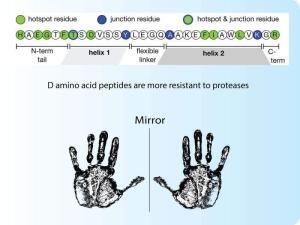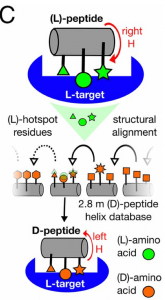Using D-amino acids as the building blocks for bioactive peptides can dramatically increase their potency. In this study, the authors generated a database of ∼2.8 million D-peptides using a mirror image of every structure in the Protein Data Bank (PDB). The critical or hotspot residues were studied. Residues critical to target binding and activity can be ideally done experimentally, such as by alanine scanning mutagenesis. It can also be done computationally through thermodynamic integration or free energy perturbation.
D-Amino Acids for Bioactive Peptides
Two peptides were tested to prove the concept: GLP-1 and Parathyroid Hormone. Both (L)- and (D)-peptides were synthesized by Lifetein LLC.
- GLP-1 is a helical GPCR agonist as a diabetes mellitus and obesity treatment. Hotspot and junction residues are annotated in green and blue, respectively. The authors investigated the ability of (D)-GLP1 peptide to induce activation of GLP1R and compared the response with native (L)-GLP1 peptide. It was found that the D-GLP-1 performed well and was resistant to protease degradation. The retro-inversion (RI) reversing the (D)-peptide sequence was used in the experiment.

D amino acid peptides
Glucagon-Like Peptide 1, GLP – 1 (7 – 36), amide, human:
HAEGTFTSDVSSYLEGQAAKEFIAWLVKGR – NH2
2. Parathyroid Hormone (PTH) is an FDA-approved treatment for osteoporosis. The (D)-PTH activates PTH1R with potency and efficacy comparable to (L)-PTH. And more than 85% of the (D)-PTH analog is still detectable at six hours.
PTH 1-34: SVSEIQLMHNLGKHLNSMERVEWLRKKLQDVHNF
Conclusion: The D-Protein Data Bank (PDB) can be used to search and find therapeutically active topologies. The D-PDB could be a vital tool for finding stable lead molecules in early-stage drug discovery.

Hot spot residues for receptor binding
Reference:
